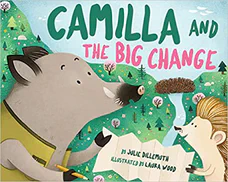Camilla and the Big Change
Written by Julie Dillemuth, Ph.D.
Illustrated by Laura Wood
32 pages
•
Published 2022 (Magination Press)

Recommended Age Range: Kindergarten through 2nd grade.
Publisher's Summary:
When beavers move in and start building a dam, the path of the river will be forever changed. Camilla does NOT want a pond in the middle of her forest! It’s too much change. But when her map-making skills are needed for the pond construction, can Camilla accept that change can be a good thing? Includes a Note to Parents & Caregivers with more information about map-making and spatial awareness, but also adapting to new environments and building community—important skills for boars, porcupines, beavers, and kids alike!

Dr. Annie's Takeaways
Recommended for: Children who have a hard time with change will relate to Camilla who initially struggles to adjust to a beaver dam turning her forest’s creek into a pond. With time and participation in preparing the forest community for the change, Camilla ultimately concludes that “there’s lots to like about a pond.” This story is particularly relevant to kids who love maps, as Camilla is a cartographer and maps play a big role in her adjustment to the change.
Would a child like it? Children who like maps and/or beavers will enjoy this story about adjusting to a big change. It’s a cute story with a relatable wild boar protagonist.
Evidence-Based Practices:
Exposure
Tone: Bright, uplifting
Story Quality: This story combines fairly disparate themes of ecosystems, map-making, and adjusting to change, which more or less come together smoothly. It’s written as a sequel to Dillemuth’s Camilla, Cartographer, but it stands alone just fine. Camilla loves maps and map-making, and she doesn’t love change. When a pair of beavers move in and plan to build a dam, Camilla must adjust to the new topography of her forest. It’s a clever concept for a book about change.
Illustrations: Cute, lightly stylized drawings in warm, earthy colors.
Representation: Camilla is a female wild boar who loves maps. Her friend Parsley is a porcupine with no gender indicators. Male and female beavers, Castor and Luisa, move into the forest and build a dam. The animals live in human-like homes in a forest.
Psychological Practices: This story empathizes with Camilla who, over the course of the book, must adjust to the big change that is occurring in her forest (i.e., a dam being built by the new beaver residents who are turning the creek into a pond), and it presents the possibility that children can adjust to big changes, especially when they are able to have some agency in the change. Camilla is initially angry and accuses the beavers of destroying her forest. When the beavers explain that their dam-making is good for the ecosystem, and especially when she realizes that they also enjoy making maps, she begins to soften a bit. But when she realizes their dam will turn the creek into a pond, she gets angry once again: “‘It’s too much change.’ Camilla stamped her hoof… ‘It’s totally NEW. Totally unexpected. And totally permanent.’” She begins to adjust to the idea of a pond when her friend Parsley suggests that she could make a map to help the other animals move to new homes away from the flooded area. As she works to help the community prepare for the new pond, “each day Camilla got a little more used to the idea…” By the time the pond is finished, Camilla concludes, “It’s definitely a change… But there’s lots to like about a pond.”
Concerns: This isn’t the point of the book at all, but I can’t help but see a bit of a displacement narrative in this story. New residents move in and reassure the old residents that the changes they are making are good for the community, and then the old residents have to move to new areas because their previous homes get destroyed by the new changes. Beaver dams are obviously a natural part of a healthy ecosystem, and perhaps I’m a bit overly sensitive to this issue, but I wanted to name the concern.
